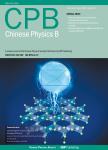Influence of Ni/Mn ratio on magnetostructural transformation and magnetocaloric effect in Ni48-xCo2Mn38+xSn12(x=0,1.0,1.5,2.0,and 2.5)ferromagnetic shape memory alloys
Influence of Ni/Mn ratio on magnetostructural transformation and magnetocaloric effect in Ni_(48-x)Co_2Mn_(38+x)Sn_(12)(x = 0, 1.0, 1.5, 2.0,and 2.5) ferromagnetic shape memory alloys作者机构:Jiangsu Key Laboratory of Advanced Micro&Nano Materials and TechnologySchool of Materials Science and EngineeringNanjing University of Science and TechnologyNanjing 210094China Herbert Gleiter Institute of NanoscienceNanjing University of Science and TechnologyNanjing 210094China
出 版 物:《Chinese Physics B》 (中国物理B(英文版))
年 卷 期:2017年第26卷第9期
页 面:428-432页
核心收录:
学科分类:07[理学] 0809[工学-电子科学与技术(可授工学、理学学位)] 070205[理学-凝聚态物理] 08[工学] 0805[工学-材料科学与工程(可授工学、理学学位)] 080502[工学-材料学] 0704[理学-天文学] 0702[理学-物理学]
基 金:Project supported by the National Natural Science Foundation of China(Grant Nos.51601092,51571121,and 11604148) the Fundamental Research Funds for the Central Universities,China(Grant Nos.30916011344 and 30916011345) Jiangsu Natural Science Foundation for Distinguished Young Scholars,China(Grant No.BK20140035) China Postdoctoral Science Foundation(Grant No.2016M591851) the Natural Science Foundation of Jiangsu Province,China(Grant Nos.BK20160833 and BK20160829) Qing Lan Project of Jiangsu Province,China Priority Academic Program Development of Jiangsu Higher Education Institutions,China NMG–NJUST Joint Scholarship Program for Ishfaq Ahmad Shah(Student ID:914116020118)
主 题:Ni–Co–Mn–Sn alloy magnetostructural transformation magnetocaloric effect magnetic entropy change
摘 要:An investigation on the magnetostructural transformation and magnetocaloric properties of Ni48-xCo2Mn38+xSn12(x = 0, 1.0, 1.5, 2.0, and 2.5) ferromagnetic shape memory alloys is carried out. With the partial replacement of Ni by Mn in the Ni_(48)Co2Mn38Sn12 alloy, the electron concentration decreases. As a result, the martensitic transformation temperature is decreased into the temperature window between the Curie-temperatures of austenite and martensite. Thus, the samples with x = 1.5 and 2.0 exhibit the magnetostructural transformation between the weak-magnetization martensite and ferromagnetic austenite at room temperature. The structural transformation can be induced not only by the temperature,but also by the magnetic field. Accompanied by the magnetic-field-induced magnetostructural transformation, a considerable magnetocaloric effect is observed. With the increase of x, the maximum entropy change decreases, but the effective magnetic cooling capacity increases.



